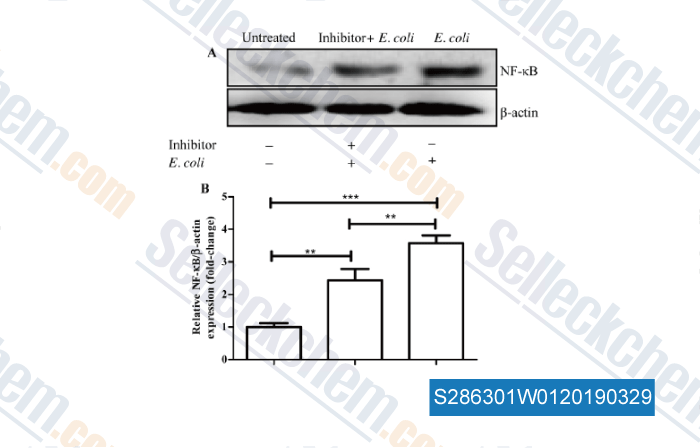|
Toll Free: (877) 796-6397 -- USA and Canada only -- |
Fax: +1-832-582-8590 Orders: +1-832-582-8158 |
Tech Support: +1-832-582-8158 Ext:3 Please provide your Order Number in the email. |
Technical Data
| Formula | C14H13N3O2S |
||||||||||
| Molecular Weight | 287.34 | CAS No. | 799264-47-4 | ||||||||
| Solubility (25°C)* | In vitro | DMSO | 57 mg/mL (198.37 mM) | ||||||||
| Ethanol | 2 mg/mL (6.96 mM) | ||||||||||
| Water | Insoluble | ||||||||||
| In vivo (Add solvents to the product individually and in order) |
|
||||||||||
|
* <1 mg/ml means slightly soluble or insoluble. * Please note that Selleck tests the solubility of all compounds in-house, and the actual solubility may differ slightly from published values. This is normal and is due to slight batch-to-batch variations. * Room temperature shipping (Stability testing shows this product can be shipped without any cooling measures.) |
|||||||||||
Preparing Stock Solutions
Biological Activity
| Description | Nodinitib-1(ML130) is a potent and selective inhibitor of NOD1 with IC50 of 0.56 μM, inhibits NF-κB activation, exhibits 36-fold selectivity over NOD2. | ||
|---|---|---|---|
| Targets |
|
||
| In vitro | ML130 has shown selective inhibition of NOD1-induced NF-κB activation in HEK293 cells with no cytotoxicity and is selected as a probe candidate molecule. ML130 is also confirmed in secondary assays by selectively inhibiting NOD1-dependent IL-8 secretion and also selectively inhibiting the NOD1-dependent pathway to NF-κB activation. [1] In another research, ML130 is proved to cause conformational changes of NOD1 in vitro and alter NOD1 subcellular targeting in cells, providing chemical probes for interrogating mechanisms regulating NOD1 activity and tools for exploring the roles of NOD1 in various infectious and inflammatory diseases. [2] |
Protocol (from reference)
| Kinase Assay: |
|
|---|---|
| Cell Assay: |
|
References
|
Customer Product Validation

-
, , Gut, 2016, 66(6):1060-1073

-
Data from [Data independently produced by , , Vet Immunol Immunopathol, 2015, 168(1-2):68-76]
Selleck's Nodinitib-1 (ML130) has been cited by 9 publications
| Adh Promotes Actinobacillus pleuropneumoniae Survival in Porcine Alveolar Macrophages by Inhibiting CHAC2-Mediated Respiratory Burst and Inflammatory Cytokine Expression [ Cells, 2023, 12(5)696] | PubMed: 36899832 |
| NOD1/RIP2 signalling enhances the microglia-driven inflammatory response and undergoes crosstalk with inflammatory cytokines to exacerbate brain damage following intracerebral haemorrhage in mice [ J Neuroinflammation, 2020, 17(1):364] | PubMed: 33261639 |
| A Specific Strain of Lactic Acid Bacteria, Lactobacillus paracasei, Inhibits Inflammasome Activation In Vitro and Prevents Inflammation-Related Disorders [ J Immunol, 2020, 205(3):811-821] | PubMed: 32591398 |
| Ginsenoside Rg3 protects against iE-DAP-induced endothelial-to-mesenchymal transition by regulating the miR-139-5p-NF-κB axis. [ J Ginseng Res, 2020, 44(2):300-307] | PubMed: 32148412 |
| Suppression of αvβ6 Integrin Expression by Polymicrobial Oral Biofilms in Gingival Epithelial Cells. [Bi J, et al. Sci Rep, 2017, 30;7(1):4411] | PubMed: 28667248 |
| The Helicobacter pylori type IV secretion system promotes IL-8 synthesis in a model of pediatric airway epithelium via p38 MAP kinase [Dela Pena-Ponce MG, et al. PLoS One, 2017, 12(8):e0183324] | PubMed: 28813514 |
| Impaired antibacterial autophagy links granulomatous intestinal inflammation in Niemann–Pick disease type C1 and XIAP deficiency with NOD2 variants in Crohn’s disease [Schwerd T, et al. Gut, 2016, 10.1136/gutjnl-2015-310382] | PubMed: 26953272 |
| Role of the NOD1/NF-κB pathway on bovine neutrophil responses to crude lipopolysaccharide [Wei LJ, et al. Vet J, 2016, 214:24-31] | PubMed: 27387722 |
| Effector responses of bovine blood neutrophils against Escherichia coli: Role of NOD1/NF-κB signalling pathway [Tan X, et al. Vet Immunol Immunopathol, 2015, 168(1-2):68-76] | PubMed: 26321220 |
RETURN POLICY
Selleck Chemical’s Unconditional Return Policy ensures a smooth online shopping experience for our customers. If you are in any way unsatisfied with your purchase, you may return any item(s) within 7 days of receiving it. In the event of product quality issues, either protocol related or product related problems, you may return any item(s) within 365 days from the original purchase date. Please follow the instructions below when returning products.
SHIPPING AND STORAGE
Selleck products are transported at room temperature. If you receive the product at room temperature, please rest assured, the Selleck Quality Inspection Department has conducted experiments to verify that the normal temperature placement of one month will not affect the biological activity of powder products. After collecting, please store the product according to the requirements described in the datasheet. Most Selleck products are stable under the recommended conditions.
NOT FOR HUMAN, VETERINARY DIAGNOSTIC OR THERAPEUTIC USE.
